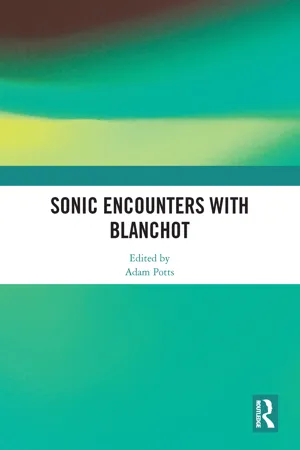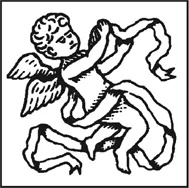translator’s foreword
After completing his studies in 1930, Maurice Blanchot became a journalist with the conservative Paris daily Journal des débats. Though he quickly found his niche as a commentator on domestic, then predominantly international, affairs, his apprenticeship consisted, as he wrote in later life, in “learning to do everything in order to be able to do everything” (Nancy 57). Most of his early writing was no doubt unsigned, but he was allowed the occasional byline. In December 1931, he tried his hand as a film critic, with a review of Harry Lachman’s Mistigri (“La Première de ‘Mistigri’ au Théâtre Marigny” 4). The following year, he reviewed the concert given on 17 June 1932 to accompany the unveiling of the monument to Debussy on the boulevard Lannes, which took place on the same day. This was a grand affair. Eighty cities around the world subscribed to the monument, and the ceremony was attended by numerous foreign dignitaries, including the British Ambassador, Lord Tyrell. While most newspapers gave prominence to the unveiling of the monument, the Débats followed the two unsigned articles it devoted to the ceremony on 18 June with a piece by Blanchot the following day, devoted entirely to the concert.
Speakers at the unveiling ceremony went out of their way to emphasise Debussy’s status as a French composer. D’Annunzio’s name for him, “Claude de France,” was cited, as well as the signature that Debussy made his own late in life: “Claude Debussy, musicien français,” which is engraved on the Martel brothers’ monument. The newspaper reports both echo and amplify this patriotic view. All the more striking in this context is the tenor of Blanchot’s article. It is well known that, in parallel with his regular employment at the Débats, he also wrote for a range of extreme right-wing journals between 1932 and 1937, where he defended an increasingly strident nationalist position. Yet his view of Debussy diverges significantly from the prevailing patriotic one. In a speech at the unveiling ceremony, Jean Mistler claimed that “the distinctive features of Debussy’s musical physiognomy are the most permanent characteristics of our national genius [du genie de notre race].” 1 Blanchot appears to echo this when he links Debussy’s music to l’esprit de notre race, using in his turn a term which, though “innocent” at the time in as much as it served primarily to identify national characteristics rather than ethnic difference, was primed to serve an increasingly racist purpose as the decade wore on. However, what Blanchot calls “the purest and most general form of the art of music itself” is no more identical to the French national spirit in his view than it is unique to the “genius” of Debussy. There is no “national aestheticism” here. France as a model of perfection does not derive its wholeness from the perfection of art, it is traversed by that perfection. However exceptional its access to music itself may be thanks to a composer like Debussy, its “national spirit” is always transcended by music as art. Art is thus not only more important than the artist, as Blanchot states at the outset, it subordinates “race” or nation to a higher human value. 2 This is undeniably still a Western value. Music in its general form remains Western music. It is noteworthy, however, in the light of the fierce anti-Germanism of the nationalist right at the time, that “Western” is not the same as “Latin” in Blanchot’s view: Toscanini was present alongside Weingartner, the radio link was between Paris and Basel. 3 Yet if their participation ensures that the festival is more than simply a national celebration, it does not make “music in general” an international value. It is rather a supranational one, locating human perfection outside of politics in its current, nation-centred expression, and subordinating national community to a relation – art – that diverges totally from it.
A second observation that Blanchot makes in his review extends this notion of divergence. In Pelléas, he writes, Maeterlinck sets up a distance between words and what they express, and that distance or gap into which Debussy’s music penetrates is the milieu in which all art takes place. That being so, art diverges from the nation as a value not just because it is a superior value, but because it is by nature a divergence. It differs because it is nothing other than difference. It is noteworthy that at the very outset of his career, the twenty-five-year-old Blanchot has already laid the basis for the relation to both literature and politics that he will develop in the writing for which he will later be known.
• • •
The finest homage we can pay a great artist is to be attentive to the varied nuances of his art. It is his work that honours his memory above all else. Yesterday, the monument dedicated to Claude Debussy was formally presented to the City of Paris. In the evening, a day that was almost entirely devoted to the composer came to a close with a festival at the Théâtre des Champs-Elysées, in the presence of the President of the Republic and numerous dignitaries. This was a fitting homage for which we have the dedication of M. Gabriel Astruc to thank. By taking part themselves, the finest foreign musicians ensured that their countries too were associated with the event. The presence of Artur Toscanini and the participation of Felix Weingartner were proof that this festival did not just celebrate a French musician, it was a celebration of music itself. There could be no better reminder that the part of our national spirit [l’esprit de notre race] that found expression in Debussy corresponds to the art of music in its purest and most general form.
The programme was designed with this consideration in mind. Most of the works performed yesterday are very well known, and form part of the repertoire of our great ensembles. But their unusual combination brought home the extreme diversity of Debussy’s work, which some have criticised for its lack of variety, though not for its richness. The festival began with the first act of Le Martyre de Saint Sébastien. It was an excellent idea to give pride of place to what is the culmination and almost the conclusion of Debussy’s work, and what also gives the lie most effectively to the impressionism to which some would seek to reduce it. The magic contained in these pages is expressed with a solemn density in which mystery is not exhausted by its sensual forms. Even in the most violent passages, the tone remains sober and severe: the presence of a secret force is palpable, and seems to be generated by the internal rhythm.
Nothing could be more different from this mystery, whose bare, pared down perfection was ably sustained by the conductor Philippe Gaubert, than the buoyant joy, the disciplined tumult, the sensuous charm of the Nocturnes. Gabriel Pierné has often conducted them and they have almost become his personal property. It is hard now to imagine them without him. He brings to them a peerless distinction and a concern for clarity which are perfectly adapted to a search for the finest gradations and nuances. Yesterday he gave one of his best interpretations of the first and second Nocturnes, emphasising their soaring movement in which irony becomes grace and where in Fêtes, the urgent tempo of the rhythmic patterns gradually increases, in anticipation of the approaching procession.
The ovation given to the conductor of the Concerts Colonne was no sooner over than the announcement came that we were to hear the Prélude à l’après-midi d’un faune, performed in Basel under the baton of Felix Weingartner and broadcast to the Théâtre des Champs-Elysées by wireless. “The distant call of the faun” has rarely come from so far off in a public concert. Unfortunately, the flute had lost some of its dreamy tones along the way, and we could only guess what soul of harmony Mr Weingartner must have awakened. What we heard was merely the ghost of it, even though the broadcast appeared excellent from a radiophonic point of view.
Next, Mr Toscanini conducted the symphonic poem La Mer. This is one of the finest spectacles there is to behold. We are all familiar with the extraordinary fire that distinguishes each one of Toscanini’s performances. But what surprises us each time and beguiles us anew is the firm control that he exercises over this ardour, containing it without ever letting it be curtailed. Precision and exactitude are called upon to convey the feeling of what is indistinct and incomplete, in the movement of those waves, and in the long dialogue between the wind and the sea. He takes the impressionism of the work to its limits, and in so doing exposes its secret structure. Toscanini’s performance brought the house down, and his triumph was also that of the orchestra, which contained musicians from the Opéra and the Opéra-Comique, as well as from our great symphonic associations.
The festival ended with the fourth act of Pelléas et Mélisande. The presence of the original creators of the principal roles, Mary Garden, Hector Dufranne and Félix Vieuille, made this a most interesting performance, allowing us, if only through the memories that each of them awakened, to imagine the first performances of the work, which have never subsequently been equalled. Indeed, since that time, performances seem to have shown less respect for the spirit of the work: a trend towards greater realism is increasingly the norm; it is becoming less evident that what makes Debussy unique is the wondrous harmony linking voice, music and song that we encounter in his music. Yet in Pelléas, the words are clearly inseparable from the harmony that pervades them. If those that Maeterlinck chose are among the simplest there are, it is because through what they lack they provide the mind with an intimation of what it must go in search of. The gap or divergence that the word alludes to but does not close is the very milieu in which the soul apprehends the movement of beauty and art. It is to there that Debussy’s music penetrates, giving us the intense illusion of another world, the sensuous presence of poetry.

